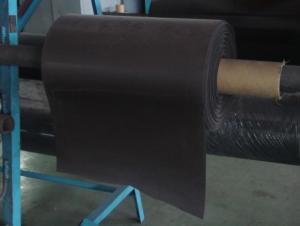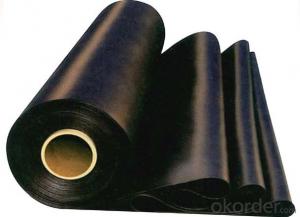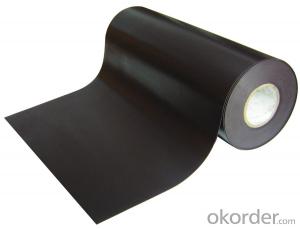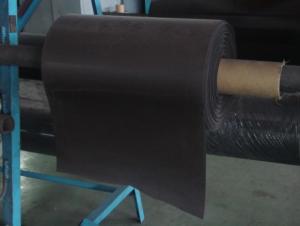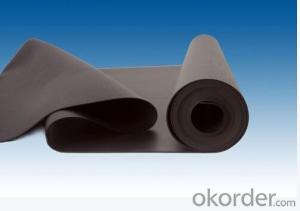Weldable EPDM Waterproofing Membrane for Roof
- Loading Port:
- China main port
- Payment Terms:
- TT OR LC
- Min Order Qty:
- 5000 m²
- Supply Capability:
- 100000 m²/month
OKorder Service Pledge
OKorder Financial Service
You Might Also Like
Introduction for EPDM Waterproofing Membrane:
Tensile Strength N/CM | Normal temperature: 60 ; 60°C: 30 |
Breaking Elongation % | Normal temperature: 400 ; -20°C: 10 |
Tear Resistance N | 20 |
Impermeability, 30 min no leakage | 0.3Mpa |
Low Temperature Bending °C | -20 |
Heating Shrinking mm | Extension: 2 Shrink: 4 |
Heat Resistance (80°C×168h) | Tensile Strength % : 80 ; Keeping rate of adhesive breaking:70 |
Alkali resistance (10% ca (oh)2 solution,normal temperature ×168h)) | Tensile Strength % : 80 ; Keeping rate of adhesive breaking:80 |
Synthetic aging | Tensile Strength % : 80 ; Keeping rate of adhesive breaking:80 |
Characteristic of EPDM Waterproofing Membrane:
This product has perfect weather resistance,durability of EPR and the weldability of polypropylene;
·It has special technology for formula with no plasticizer which embrittles material it has high flexibility without embrittling phenomenon caused by migration of plasticizer in polyolefin , to have long time waterproof performance;
·There is an interlayer of polyester fiber fabric, offering high tensile strength, fatigue resistance, puncture resistance,which is adaptive to mechanically mounted roofing system
·Excellent low and high temperature flexibility: It is flexible even under -50℃ ,and still has mechanical strength at higher temperature;
·Chemical resistance: Resistant to erosion of acid, alkali, salt, plant oil, lubricating oil, resistant to microbial growth like algae and mould etc.
·Resistance of heat aging, good dimensional stability.
·White priority light color,smooth surface, high reflectance,better energy saving effect; Pollution resistance.
·NO chlorinated polymer or chlorine gas in ingredient,therefore no emission of chlorine during welding and other process, harmless to surroundings and humans.
·We use heatsealing to overlap, in order to form a high strength sealing layer.
Usesage of EPDM Waterproofing Membrane:
Widely used in roofs, basement, toilet ,swimming pool, and all kinds of industry and civil building waterproofing, reservoir, bridge, underground, tunnel and dam waterproofing ,especially to the keystone waterproofing projects which is durability, high corrosion resistance and easy deformation
FAQ of Waterproofing Membrane
a.Can we get some samples before place order?
Answer: We can send the free samples to you by freight collect.
b.How many years can your PVC membrane guarantee?
Answer: We will guarantee the quality for 5 years at least.
c.Which countries you ever export the product?
Answer: We export the PVC membrane to South Africa, Middle east and even European countries.
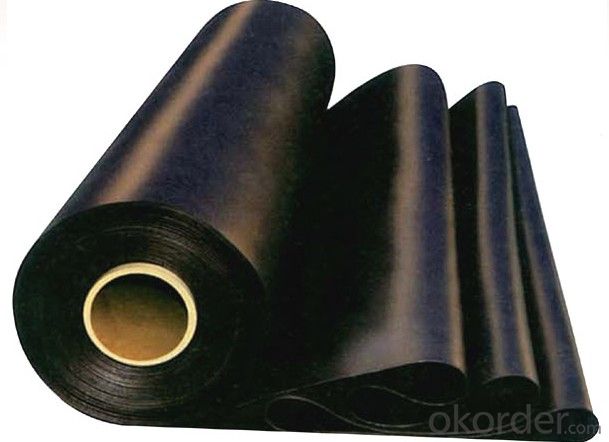
- Q: The difference between high polymer modified asphalt waterproofing membrane and sbs
- High-polymer modified asphalt waterproofing membrane: synthetic polymer modified asphalt coating layer, fiber fabric or fiber mat for the carcass, powder, granular, sheet or film material made of cladding material can be curled Of the sheet material. Thickness is generally 3mm, 4mm, 5mm, asphalt as the main body.
- Q: Are waterproofing membranes resistant to chlorine exposure?
- Waterproofing membranes can vary in their resistance to chlorine exposure. Some membranes are specifically designed to be resistant to chlorine and are commonly used in applications where chlorine exposure is expected, such as pool decks or water treatment facilities. These membranes are typically made with materials like PVC or TPO that have inherent resistance to chlorine and can withstand prolonged exposure without significant degradation. However, it is important to note that not all waterproofing membranes are chlorine-resistant. Some membranes, particularly those made with materials like EPDM or bitumen, may not be as resistant to chlorine and may experience deterioration or damage when exposed to chlorine for extended periods. To ensure the longevity and effectiveness of a waterproofing membrane in a chlorine-rich environment, it is crucial to select a membrane that is specifically designed and tested for chlorine resistance. Consulting with a waterproofing professional or manufacturer can help determine the most suitable membrane for the specific chlorine exposure conditions.
- Q: Can a waterproofing membrane be used for a crawl space?
- Yes, a waterproofing membrane can be used for a crawl space. Crawl spaces are susceptible to moisture and water intrusion, which can lead to various issues such as mold growth, structural damage, and unpleasant odors. A waterproofing membrane can act as a barrier to prevent water and moisture from seeping into the crawl space. It is typically installed on the walls and floors of the crawl space, creating a watertight seal. This membrane can effectively prevent water from entering, making it an excellent solution for crawl space waterproofing. Additionally, some waterproofing membranes also have antimicrobial properties, further reducing the risk of mold and mildew growth in the crawl space.
- Q: Can a waterproofing membrane be used for roofs with foot traffic?
- Yes, a waterproofing membrane can be used for roofs with foot traffic. However, it is important to choose a membrane that is specifically designed and rated for foot traffic. These membranes are typically made with more durable materials, such as reinforced PVC or modified bitumen, to withstand the wear and tear caused by regular foot traffic. Additionally, it is crucial to ensure that the membrane is properly installed and maintained to prevent any damage or leaks that could compromise the waterproofing capability. Regular inspections and necessary repairs should be carried out to ensure the longevity and effectiveness of the membrane.
- Q: Can waterproofing membranes be used for planter boxes?
- Yes, waterproofing membranes can be used for planter boxes. Waterproofing membranes provide a protective barrier against moisture, preventing any water leakage that could damage the planter box or surrounding areas. This helps to preserve the longevity and integrity of the planter box, making it suitable for long-term use in outdoor environments.
- Q: Can waterproofing membranes be used in basements?
- Yes, waterproofing membranes can be used in basements. Waterproofing membranes are specifically designed to provide a barrier against water penetration and are commonly used in basements to prevent moisture and water seepage. These membranes are typically made of materials such as rubber, bitumen, or polyethylene, and are applied to the basement walls and floors to create a waterproof seal. By preventing water from entering the basement, these membranes help to protect the foundation, walls, and interior spaces from water damage, mold, and other moisture-related issues. Additionally, waterproofing membranes can also be used in combination with other waterproofing techniques such as drainage systems and sump pumps to provide comprehensive protection against water infiltration in basements.
- Q: Are there different waterproofing membrane options for above-ground and below-ground applications?
- Yes, there are different waterproofing membrane options for above-ground and below-ground applications. Above-ground waterproofing membranes are typically designed to protect structures from moisture and weather elements, such as rain and UV rays. These membranes are often more focused on preventing water intrusion from the outside. On the other hand, below-ground waterproofing membranes are specifically designed to resist the hydrostatic pressure exerted by groundwater. They are more robust and are often used in basements, foundations, and other below-grade applications to prevent water penetration from the soil.
- Q: Does a waterproofing membrane require any curing time?
- Yes, a waterproofing membrane typically requires a curing time. The curing time is necessary for the membrane to fully bond and form a strong, impermeable barrier. The specific curing time can vary depending on the type of membrane and the manufacturer's instructions. During the curing process, the membrane may need to be protected from foot traffic, water exposure, or other potential damage. It is important to follow the recommended curing time to ensure the membrane's effectiveness and longevity.
- Q: Can a waterproofing membrane be used for a stadium?
- Yes, a waterproofing membrane can be used for a stadium. Waterproofing membranes are commonly used in construction projects to prevent water infiltration and protect structures from moisture damage. In the case of a stadium, a waterproofing membrane can be applied to the building's foundation, roof, or any other areas that are susceptible to water penetration. This will help ensure the longevity and structural integrity of the stadium by preventing water-related issues such as leaks, mold, and deterioration.
- Q: Is a waterproofing membrane suitable for below-grade applications?
- Yes, a waterproofing membrane is suitable for below-grade applications. Below-grade refers to areas that are below the ground level, such as basements or foundations. These areas are prone to water infiltration and moisture issues, which can lead to damage and structural problems. A waterproofing membrane is specifically designed to prevent water penetration and provide a barrier against moisture. It is applied to the exterior or interior surface of the below-grade structure, forming a continuous and durable seal. This membrane is highly effective in preventing water from seeping into the below-grade area, ensuring a dry and stable environment. It is crucial to use a waterproofing membrane in below-grade applications to protect the structure from water damage, mold growth, and other related issues.
Send your message to us
Weldable EPDM Waterproofing Membrane for Roof
- Loading Port:
- China main port
- Payment Terms:
- TT OR LC
- Min Order Qty:
- 5000 m²
- Supply Capability:
- 100000 m²/month
OKorder Service Pledge
OKorder Financial Service
Similar products
Hot products
Hot Searches
Related keywords
